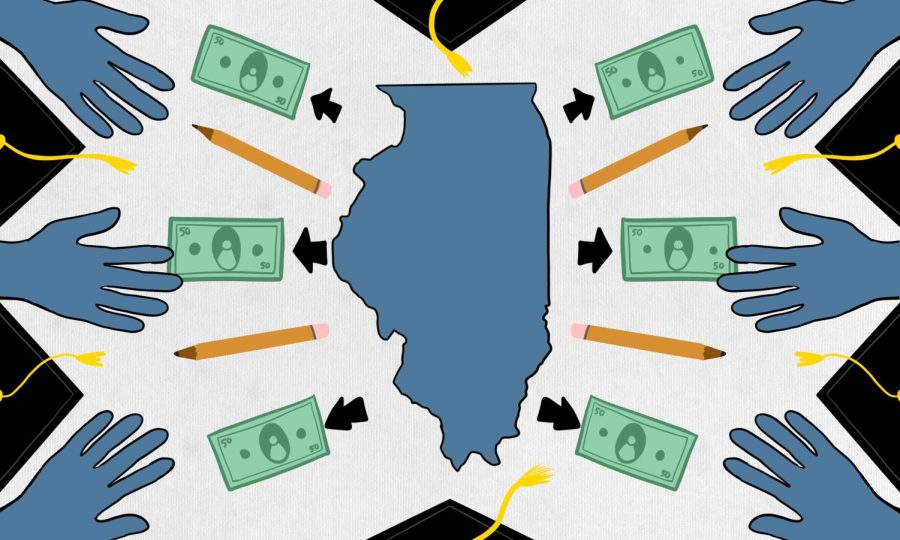Illinois funds child savings accounts, makes college saving more accessible
Legislators allocated $2.5 million to give a college savings account to children born or adopted in Illinois after Dec. 31.
April 26, 2022
Every child born or adopted in Illinois after Dec. 31 will receive a college savings account managed by the State Treasurer’s Office with a $50 starting deposit under the Higher Education Savings Program.
Three years after the Illinois General Assembly first passed the program in 2019, legislators allocated $2.5 million to fund it. The funding package, supported by parent activists throughout the state, was sponsored in part by Rep. Robyn Gabel (D-Evanston).
“I truly believe that education is the key to success, and that one’s income is directly related to one’s education,” Rep. Gabel said. “My goal is to create a healthier community, and one of the best ways to get there is to get everybody educated at the highest level we can.”
To access the funds, parents or guardians of eligible children must first claim the $50 seed funding for a child by their 10th birthday. To use the funds, the beneficiary must either turn 18 or complete high school. If the funds are unused by the beneficiary’s 26th birthday, they will be forfeited to the state.
Amy Eisenstein (Weinberg ’17), a member of Heartland Alliance’s research and policy team and its coalition manager, said parents have always been at the forefront of this movement.
The Chicago human rights nonprofit has been advocating for statewide child savings accounts for more than a decade, with the Financial Inclusion for All Illinois coalition, which includes parents, service providers and community organizations, according to Eisenstein.
“The most instrumental members of our coalition are the parent leaders that have been fighting for this for nearly a decade,” Eisenstein said. “They see this investment as really a seed of hope for the future and their children in their community.”
Some Illinois House Republicans criticized the program because they didn’t see a $50 college savings initiative as a worthwhile investment. As college tuition costs continue to rise, they said the $50 won’t cover enough impact for each individual family.
Other state legislators and activists, on the other hand, argued the program’s purpose is to kickstart saving and encourage parents to start preparing for their child’s higher education at birth. This can be especially crucial for low-income families impacted by generational wealth inequality or families where college education isn’t common and would be unable to start their own savings funds otherwise, Eisenstein said.
“In Illinois, the racial wealth gap is deep and pervasive, and there are communities that are often left out of wealth building mechanisms,” Eisenstein said. “Children’s savings accounts are a policy that we know can be powerful for promoting wealth building communities that otherwise might not see higher education savings as a possibility.”
Despite questions about its effectiveness, Gabel said research done for the Higher Education Savings Program found it doesn’t matter how much money is in a savings account — the account’s existence makes the difference.
According to Heartland Alliance’s 2017 report on children’s savings accounts, children with a college savings account are twice as likely to seriously plan on attending college.
The report also found Bright Start 529 college savings accounts, an existing state-sponsored account that offers tax benefits, are disproportionately created by individuals who are white, educated, male and higher-income.
Rosazlia Grillier, co-president emeritus of family advocacy and resource center Community Organizing and Family Issues and a parent herself, said during her organization’s advocacy work for children’s savings funds, the group realized there were many barriers to starting college savings accounts.
“529s have always existed, but they weren’t accessible to communities of color or people in financially challenged communities, and we had no knowledge of how to navigate them or even what they were,” Grillier said. “So we started to try to make it accessible to folks.”
The legislation upholding this program includes a section that will allow the Treasurer’s Office to track who takes advantage of the program to see what equity barriers may still be in place, according to Grillier.
After years of advocacy work, Grillier said it was bittersweet to see the legislation pass because of the original about $8 million requested, the group received $2.5 million. But, she said this is an important step to take to ensure saving for college is attainable for everyone.
“This is really a statement that empowers our children,” Grillier said, “$50 is not going to pay for a college education, but it can say to you, ‘I believe in you, let me help you get started.’”
Email: [email protected]
Twitter: @shannonmtyler
Related Stories:
— As tensions rise nationally over tuition, Northwestern parents weigh in
— Local early childhood education centers successfully reduce Pre-K education disparities
— From loan cancellation to Pell Grant expansion: Democratic candidates’ ideas for higher education












